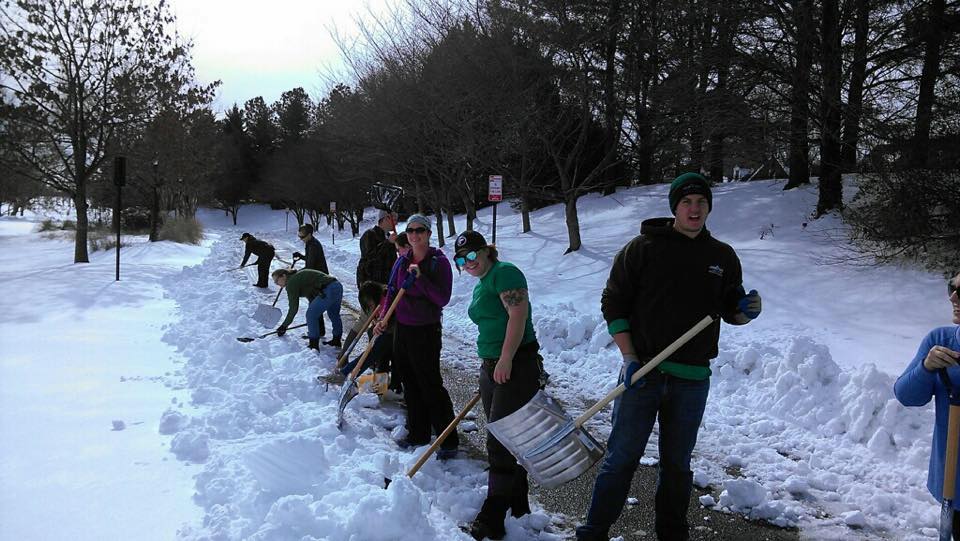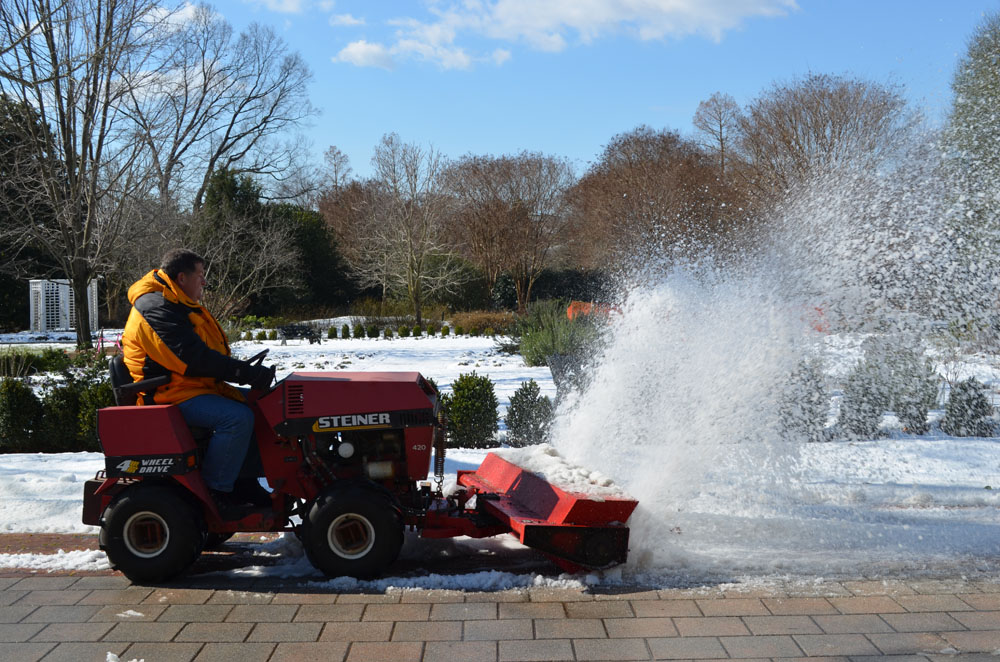Salt: Necessary Evil

Horticulture and Operations staff at the Garden work in teams shoveling snow to make walkways, drives, and parking lots safe.
In gardening as in life, the solution to one problem can be the cause of another. It happens when we burn fossil fuels for energy and the byproducts contribute to global warming. It happens with some broad spectrum pesticides, which don’t discriminate between beneficial insects and harmful pests. And so it is with salt.
Homeowners, businesses and municipalities often sprinkle rock salt or sodium-laden ice melt on walkways, roads and other hard surfaces to prevent slipping to the ground or sliding into each other on the road when temperatures drop. (It works because salt lowers the freezing point of water as it dissolves.) That’s when it falls into the category of too much of a good thing.
Joel Koci, Virginia Forestry Extension Associate at Virginia State University explains, “Deicing salts [usually sodium chloride] can injure landscape plants, contributing to their decline and sometimes even death when storm runoff leeches into the soil. It’s important to understand the impact that too much salt has on plant life and practice application strategies that will help minimize damage.”
Salt is essential for metabolism in plants. Animals and mankind need it to regulate electrolyte and fluid balance. The trouble begins when plants absorb sodium chloride in place of other essential nutrients like potassium (which helps them regulate water use and strengthens cell walls) and phosphorus (which stimulates root growth and flowering). Look for two types of salt damage in your yard: aerial and chronic. Aerial damage refers to the harm caused when salt is transported by moving air, moving objects and moving water. It appears in late winter and early spring, and is less detrimental because you can recognize it early if you know what to look for. Brown or speckled foliage, delayed bud break and distorted buds, needle and leaf loss and twig die back are all symptoms of aerial salt damage. Chronic salt damage takes longer to manifest, so we sometimes confuse it with other harm agents. It is more dangerous than aerial damage because roots are more active when the ice and snow melt in late winter. To complicate things, the damage from chronic salt damage manifests during hot dry spells or in late summer. Look for wilting, reduced fruit development, yellowing, fewer and smaller leaves, early leaf drop and premature fall color. Damage from salt runoff is even more insidious when it washes away in to waterways where it can affect aquatic life. Up to 40 percent of the nation’s urban waterways and groundwater contain chloride at levels considered unsafe for aquatic life.
You can see why salt damage is tough to recognize in your garden: it looks just like distress caused by so many other things. Koci recommends a soil sample test as the best indicator of what’s causing trouble in your yard. Soil sample test kits are available at your county library or your local Virginia Cooperative Extension Service office. In Virginia, soil samples are sent to the Virginia Tech Soil Testing Lab to be analyzed. Results are mailed from the lab within 3 working days and include recommendations for correcting any imbalance revealed by the test.

Clearing snow manually, with a shovel, broom or snow blower, is the best way to prevent plant damage from dangerous chemicals.
The easiest way to avoid salt damage to your plants is by not using it. Here at Lewis Ginter Botanical Garden we use salt containing products sparingly and opt for sand as an alternative when we can, especially in areas near plants. And there’s nothing like shoveling for an ecologically sound solution to snow removal. Just be sure to shovel before the snow melts and refreezes. There are also some slightly more environmentally friendly products like calcium chloride, magnesium chloride and potassium chloride, but they still aren’t great for concrete, your car, or the environment. These products also tend to be substantially more expensive than sodium chloride. Some safer deicers even use a binding agent similar to corn syrup to help them work.
Grace Elton, Director of Horticulture describes that “in a public garden, we have to balance visitor safety with protecting our plant collections. We try to use sand wherever possible and more often than not, we can allow the sun to melt most of the snow before we open the garden to visitors.” When we do use deicers, we use them sparingly, mostly in our parking lots.
But if you are going to use deicing products, instead of diagnosing salt damage after the fact, let’s look at how you might minimize the damage in the first place:
- Salt before a storm, not after: This will help prevent snow and ice from binding to the asphalt and help make post-storm cleanup easier.
- Mix salt with a small amount of water to make it easier to spread, and blend in sand, gravel or cat litter to improve traction on slippery surfaces.
- Choose plants for your garden that are more salt tolerant, especially around pathways where runoff is most concentrated.
- Apply salt melts in moderation avoiding pavement close to planting beds.
- Check to be sure you have proper drainage where runoff occurs, which will help dilute the concentration of salts by allowing it to seep deeper and more quickly into the soil.
- Create a physical barrier against aerial damage by stretching black plastic sheeting or burlap between a pair of wooden stakes.
- Insure that your beds have good, healthy, deep soil and allow your plants an increased root zone.
- Stop using deicer by late winter. As the plants break from dormancy they are more likely to absorb the salts.
In 2014 the Smithsonian reported that we spread more than 22 million tons of salt on roadways annually in the United States. They estimate that works out to about 137 pounds of salt for every American. But take heart. In recent years, municipalities have been experimenting with alternate deicing compounds like beet juice, molasses and cheese brine mixed with salt to help reduce the overall chloride load on the environment. Those sound like deicing agents Mother Nature would dig.